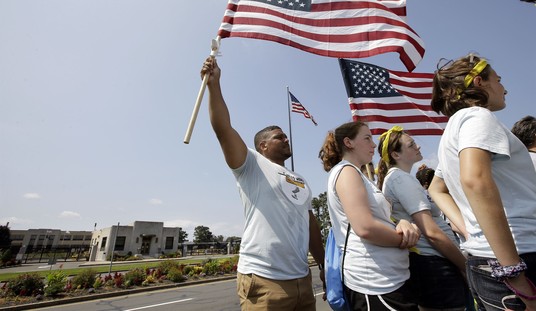Over the past 50 years, much of the focus of governmental effort has been to reduce risk in all areas of human activity. The results have often led to failure and stagnation.
Think back to 1969. In that year, astronauts from Apollo 11 first landed on the moon, the SR-71 was being used for reconnaissance over Vietnam and North Korea, and the 747 took to the sky to revolutionize air travel for all. Each of those accomplishments was the product of incredible risk. Astronauts from Apollo 1 had died on the launch pad in an oxygen fire. SR-71 type planes crashed during the course of their lifetime, though none were ever shot down. And as to the 747, Boeing bet the company on the new plane, after Wall Street refused to fund a 200 seat Concorde competitor that President Kennedy had encouraged. The financial risk taken by Boeing was greater than the value of the company at the time.
Risk, as the word implies, means that there is a chance for failure. Every human activity involves risk. Some number of people die each year getting out of bed, or slipping in the shower or are killed in car accidents. Yet, most people are willing to take the risks of doing these activities, as they conclude that those risks are relatively small in comparison to the benefits of doing these things. The importance of taking risks revolves around the fact that there can be no real success unless there is some chance for failure. Eisenhower famously wrote a letter of responsibility for a failed Normandy landing. The massive undertaking was needed to break Nazi power, but there was a significant risk it could fail, and the Supreme Allied Commander knew that the whole enterprise could end in disaster—and thus his letter, which we should all be very grateful that he never had to read.
Recommended
Now let’s look at the more recent response to Covid. All of the governmental directives—masks, distancing, lockdowns, school closures, vaccines—were intended to mitigate risk of an engineered virus that for the vast majority of the population was not a significant health risk. The results have been catastrophic, from the businesses that went under to the children who learned nothing for two years, from increased rates of depression and suicide to inflation from all of the money pumped into the economy that could no longer produce or provide products as it had before the virus. The countries that tried to minimize risk destroyed their societies but did not show significantly better health outcomes than those whose approach was more laissez-faire.
If one looks at the 20 most valuable companies in the world today, he will see that relatively young American firms dominate. Let’s assume that a high market value is a measure of corporate success. Other than Saudi Aramco, there is no non-American country in the top 15 slots. The first European company to show up is LVMH, the owner of high end goods like Louis Vuitton and Moët & Chandon. Louis Vuitton was founded in 1854 and Moët & Chandon goes back to 1743. The only other European firm in the top 20 is a drug firm, Novo Nordisk, founded in 1923. One Chinese company, Tencent, rounds out the top 20. How is it that the US has 80 percent of the most valuable firms in the world, while Europe has two and China only one? The answer is risk. Bernie Sanders, AOC, and Elizabeth Warren types like to rail against billionaires (though they don’t seem to mind being millionaires themselves), but did they ever look into the risks that the founders of Apple, Microsoft, Tesla and other top companies took? There were no guarantees of success. There was no governmental European-style safety net to save them if their businesses went south. Years of toil and potentially millions of investment dollars driven into a company could have yielded nothing. Look at all of the startups that blew through millions and years of their founders’ lives and ended up padlocking the premises. The owners of successful companies, big and small, took risks and came out on the good side of the risk curve. Many did not. But because we have people willing to take risks, we have new products and new solutions to problems ranging from cancer therapies to more efficient transportation. San Francisco and other cities in the West were born of those who came to make their fortunes mining gold, silver and other precious metals. Few became super wealthy, but the West became populated and the US benefited from the growth.
If one wants to see what happens when people are risk averse, look no further than Europe. We were in Europe last week, and while the alpine views were extraordinary, the country we visited seemed lethargic. While we enjoyed ourselves, all of my family said that they wished that we could be in the States. There is a more dynamic vitality, the people are friendlier, and the vibe is more positive than where we were. Europe and the European Union have done everything to remove risk from the lives of their citizens. A popular idea in several European countries, one also floated in the US, is a guaranteed income. Gone is the risk of not having money and not having food; gone too is the reason to get out of bed and try to find some work. While leaders might see a guaranteed income as a form of kindness, in reality it is a way to destroy a person’s desire to make something of himself. Ditto for reparations. The EU has endless rules on every aspect of human activity, from lawn mower specifications to the shape of olive oil bottles in restaurants. Their goal is not to encourage human activity but rather to control every aspect of one’s existence—for the person’s own benefit. The same disease is growing in the States, as the government wants to tell people what type of cars or stoves or water heaters they can own. And it's always for our benefit—they falsely claim that the world will heat up uncontrollably if you do not move to an electric car, electric stove top and electric water heater. That China and India smartly do nothing in this direction means that all of these efforts are meaningless at best in a fake climate crisis that is used to control how we live. As governments get bigger, their desire to control more aspects of our lives only grows.
While one does not have to be a risk-taker like Tom Cruise doing his own movie stunts, there is a need for some risk acceptance. Years ago, I saw a video of new recruits starting their careers in the British Navy. One of the activities they had was for the new sailors to jump into a circle. The first few had no problem, but as the space filled up, newer jumpers had more of a challenge—the goal was to teach working together. Why do I recount this story? Because all of the sailors had to wear hard hats. We’re not talking about jumping out of an airplane or engaging in active combat. Rather, a fairly simple and not very dangerous activity required a helmet to prevent a head trauma that probably would happen once in 10 years. What’s the problem with adding a little more safety and mitigating a little more risk? The problem is that we become more and more afraid of doing things, even things that we need to do.
The exterior of the Empire State Building was built in 13 and a half months; five workers died during the construction. Today, on a similar project, OSHA would make sure that no one would die and the project would take three years or longer—after years of litigation and environmental impact studies. Mitigating risk seems like a noble goal, but often it also mitigates our ability to succeed or progress. Our lives are becoming more and more regulated and we can do less and less. We are encouraged to avoid risk and take the safe path. The safe path did not produce any of the companies on the Fortune 500 list. America was built and advanced by risk takers, from those who took the risk of breaking with England to those who set up last week a new neighborhood bakery with bank loans. We need to rediscover and encourage that truly American ethos of risk taking in order to enjoy another great American century.

























Join the conversation as a VIP Member